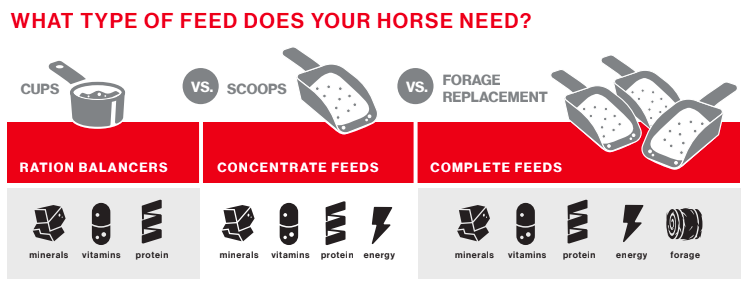101 On Feeding Ration Balancers For Horses

Ration balancers have been a feed option for horse owners for a long time. But why is there still so much mystique around feeding this nutrient-dense pellet option?
Heels Down asked an expert to explain. Equine Nutritionist Dr. Kelly Vineyard with Purina Animal Nutrition stopped by to talk about the ins and outs of feeding ration balancers, and why they are often a healthy option for a variety of types of horses.

So to start, what is a ration balancer? And how do they differ from a more traditional feed?
When you think about the feed you can buy at your local feed store, there are generally three different categories. One category would be a ration balancer, which is a concentrated formula providing protein, vitamins, and minerals and designed to be fed at a low feeding rate, typically 1 – 2 pounds per day. A complete feed is another category – which is a feed that can replace or partially
replace hay in the diet (think: a typical senior feed). And the third category is a concentrate feed, like a pelleted or sweet feed, which is designed to supply essential nutrients and isn’t meant to replace hay, but still provide calories.
Where do ration balancers fit in here? Well, a ration balancer is like a concentrate feed in that it supplies essential nutrients, but it’s different because it is not intended to supply calories. A balancer does just that – it balances a forage-based ration. The main component of a horse’s diet would be hay and grass, and the ration balancer is fed to balance the nutrients that are missing in a forage-based diet. Sometimes forage will not contain enough amino acids, vitamins, and trace minerals to meet the horse’s daily requirement.
The balancer helps fill in those gaps. It’s the insurance policy to ensure you are meeting their nutritional needs on a forage-based diet. A ration balancer is great for a horse considered an easy keeper, and who might get too fat on a concentrate feed.
So how much of a ration balancer do you need to feed?
Traditionally ration balancers are fed 1 to 2 pounds a day to keep the calories fairly low. For example, a concentrate feed will be fed at a rate greater than that, and it has other ingredients in it to provide more calories. Ration balancers are fed at low volume to keep those calories low.

When would be an appropriate time to consider a ration balancer?
It all depends on the daily calorie needs of the horse. Horses that can maintain a healthy weight and body condition on forage alone are good candidates for a ration balancer. This includes easy keeping sedentary and performance horses. Ration balancers can also be used in growing and breeding horses – it’s a safe option for broodmares through the third trimester. But most mares need more calories once they start lactating.
Ration balancers can be fed alone or top dressed like a supplement, too. It’s a great source of protein, and could be beneficial in scenarios where you want to provide more amino acids. For example, if you’re feeding a horse below the recommended volume of concentrate feed, you may consider adding a ration balancer or switching to one fully instead so that your horse is getting enough essential nutrients. The minimum recommended daily feeding rates should be clearly indicated on a feed tag, so read the feeding directions to make sure your horse is getting the right level of nutrition.
I also recommend ration balancers for horses on stall rest, when horses may not need additional calories when they can’t expend that energy, but they still need essential nutrients to support healing and overall health.
What ‘types’ of balancers are there?
Most ration balancers consist of high-quality protein source like soybean meal with added vitamins and minerals. A good example of a traditional ration balancer is Purina® Enrich Plus®, which has been on the market for a long time. Purina has recently introduced two newer and more advanced balancer formulations with added benefits for the horse. Purina® Omega Match® is a ration
balancer formulated without soy, alfalfa, wheat, and molasses for horses with ingredient sensitivities and contains added essential omega 3s and antioxidants naturally found in green grass for horses with limited access to fresh pasture.
Purina® Enrich Plus® Senior, introduced in June, is formulated with Easy-Soak™ pellet technology, and it contains all benefits of Enrich Plus® along with added Outlast® for gastric support and ActivAge® for optimal immune function, mobility, and metabolism. This means Enrich Plus Senior is still a great option for metabolic horses and easy keepers, but it is also an excellent choice for easy-keeper, senior and performance horses too.
To find the right Purina® Ration Balancer for your horse, visit PurinaMills.com/rationbalancers.


